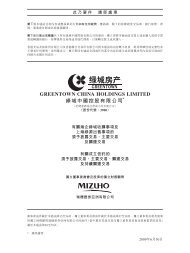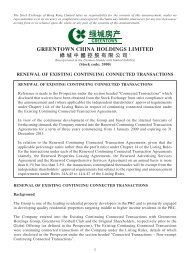Annual Report 2009 - Greentown China Holdings Limited
Annual Report 2009 - Greentown China Holdings Limited
Annual Report 2009 - Greentown China Holdings Limited
Create successful ePaper yourself
Turn your PDF publications into a flip-book with our unique Google optimized e-Paper software.
Notes to the Consolidated Financial Statements<br />
For The Year Ended 31 December <strong>2009</strong><br />
3. PRINCIPAL ACCOUNTING POLICIES (Continued)<br />
Financial instruments (Continued)<br />
Impairment of financial assets (Continued)<br />
For certain categories of financial assets, such as trade and other receivables, assets that are assessed not to be<br />
impaired individually are subsequently assessed for impairment on a collective basis. Objective evidence of<br />
impairment for a portfolio of receivables could include the Group’s past experience of collecting payments, an<br />
increase in the number of delayed payments in the portfolio past the average credit period of 90 days, observable<br />
changes in national or local economic conditions that correlate with default on receivables.<br />
For financial assets carried at amortised cost, an impairment loss is recognised in profit or loss when there is<br />
objective evidence that the asset is impaired, and is measured as the difference between the asset’s carrying<br />
amount and the present value of the estimated future cash flows discounted at the original effective interest rate.<br />
For financial assets carried at cost, the amount of the impairment loss is measured as the difference between<br />
the asset’s carrying amount and the present value of the estimated future cash flows discounted at the current<br />
market rate of return for a similar financial asset. Such impairment loss will not be reversed in subsequent<br />
periods.<br />
The carrying amount of the financial asset is reduced by the impairment loss directly for all financial assets<br />
with the exception of trade and other receivables, where the carrying amount is reduced through the use of an<br />
allowance account. Changes in the carrying amount of the allowance account are recognised in profit or loss.<br />
When a trade or other receivable is considered uncollectible, it is written off against the allowance account.<br />
Subsequent recoveries of amounts previously written off are credited to profit or loss.<br />
For financial assets measured at amortised cost, if, in a subsequent period, the amount of impairment loss<br />
decreases and the decrease can be related objectively to an event occurring after the impairment loss was<br />
recognised, the previously recognised impairment loss is reversed through profit or loss to the extent that the<br />
carrying amount of the asset at the date the impairment is reversed does not exceed what the amortised cost<br />
would have been had the impairment not been recognised.<br />
Financial liabilities and equity<br />
Financial liabilities and equity instruments issued by a group entity are classified according to the substance of<br />
the contractual arrangements entered into and the definitions of a financial liability and an equity instrument.<br />
An equity instrument is any contract that evidences a residual interest in the assets of the Group after deducting<br />
all of its liabilities. The Group’s financial liabilities are generally classified into financial liabilities at FVTPL and<br />
other financial liabilities.<br />
Effective interest method<br />
The effective interest method is a method of calculating the amortised cost of a financial liability and of<br />
allocating interest expense over the relevant period. The effective interest rate is the rate that exactly discounts<br />
estimated future cash payments through the expected life of the financial liability, or, where appropriate, a<br />
shorter period.<br />
Interest expense is recognised on an effective interest basis.<br />
114<br />
<strong>Greentown</strong> <strong>China</strong> <strong>Holdings</strong> <strong>Limited</strong> <strong>Annual</strong> <strong>Report</strong> <strong>2009</strong>








